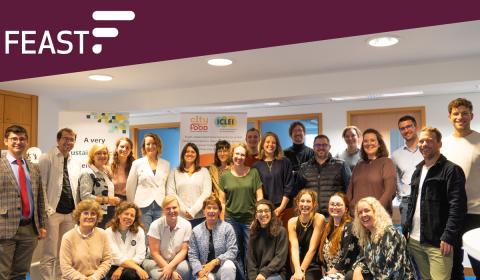
Image source: micheile henderson on Unsplash
Welcome to our blog post on carbon credits. In this blog post, we will explore the advantages and disadvantages of carbon credits, including their effectiveness in addressing the main problem, as well as the problems of the commodification of nature.
Introduction
In the pursuit of sustainability and achieving carbon neutrality, numerous food and beverage companies are adopting carbon credits as a strategic approach. With more than a quarter of the world's leading food and beverage companies committing to net-zero goals, the carbon credit market is expected to see significant growth. Carbon credits allow companies to offset their greenhouse gas (GHG) emissions by investing in initiatives that either reduce or eliminate equivalent emissions elsewhere. Typically, each credit signifies the reduction of one metric ton of carbon dioxide equivalent. 1,2
Critique of Carbon Credits
While carbon credits are popular, they reveal deep flaws within their economic structure. Focus on profit maximization perpetuates environmental problems, making market mechanisms like carbon credits ineffective in addressing the root causes. Carbon offsetting operates by allowing companies to mitigate their environmental footprint through financial investment in renewable energy or other carbon reduction projects, but this system often overlooks the necessity for profound systemic changes. 3
The reliance on market dynamics means the value of carbon credits fluctuates based on supply and demand, driven by regulatory frameworks like Emissions Trading Systems (ETS). Europe has an established ETS, and similar systems are emerging in the US, Canada, Australia, and New Zealand, indicating growing demand for carbon credits. However, this market-based approach fails to consider that the fundamental issue is the unchecked exploitation of natural resources for profit, not merely the need to offset emissions. 4
Denmark's coalition government has decided to implement the world's first carbon emissions tax on agriculture, which will impose new taxes on livestock beginning in 2030. Danish farmers' group Bæredygtigt Landbrug criticized the new carbon tax as bureaucratic and harmful to green investments. Arla Foods' CEO found the tax positive but unfair to farmers already working to reduce emissions. DLG Group's CEO emphasized the need for the tax to align with EU legislation to maintain competitiveness and avoid unilateral action. 5
Commodification of Nature
The commodification of nature, where environmental resources are treated as tradable commodities, does not lead to genuine sustainability. By turning carbon sequestration and emission reductions into market transactions, we risk ignoring the broader ecological impacts. For instance, extensive tree planting initiatives may worsen soil degradation or present biosecurity threats, undermining the anticipated environmental advantages. This approach also shifts the burden of emission reductions to the Global South, where land-use changes for carbon projects can displace local communities and disrupt ecosystems. 11
One notable example of this is large-scale afforestation projects. While these projects aim to sequester carbon, they can lead to significant ecological disturbances. Extensive tree planting in areas not naturally forested can disrupt local ecosystems, water cycles, and soil health. In the Global South, projects like REDD+ (Reducing Emissions from Deforestation and Forest Degradation) have led to the displacement of indigenous communities, further exacerbating social inequities. 6,12
Corporate Commitments and Greenwashing
Corporate commitments to net-zero emissions often mask deeper issues of exploitation and environmental harm. Since the 2015 Paris Agreement, many major companies have committed to carbon neutrality through carbon credits, driven by ethical considerations and other motivations. However, reviews reveal misalignment with the Paris Agreement's goals. Many companies rely heavily on carbon offsets, potentially skyrocketing demand for credits and straining the voluntary carbon market's capacity.13
Greenwashing occurs when companies use carbon credits to create a false image of environmental responsibility. For example, Virgin Atlantic's afforestation project in Cambodia aimed to offset carbon, but ongoing deforestation reversed the benefits, exposing the project as ineffective. Similarly, the use of non-verified credits or those without true additionality, as seen with the Massachusetts Audubon Society's forest conservation credits, further undermines the integrity of carbon offsetting initiatives. 9
In the Global South, projects like the REDD+ initiative can displace local communities and disrupt traditional livelihoods. Despite their aim to protect forests, such projects often ignore the social and economic implications for the people living in those areas. 7,8
The world's most profitable and polluting companies have invested in carbon offset projects that have significant flaws, indicating that industry claims about reducing greenhouse gases were likely exaggerated, according to a recent analysis. Delta, Gucci, Volkswagen, ExxonMobil, Disney, easyJet, and Nestlé are some of the major companies that have bought millions of carbon credits from supposedly climate-friendly projects that are ineffective for offsetting their greenhouse gas emissions, based on a classification system by Corporate Accountability. Some of these companies have stopped using CO2 offsets as growing evidence shows that carbon trading does not achieve the promised emission reductions and may even result in environmental and social damage. Nearly 36% of the 2.2 million carbon credits bought by Nestlé, the world's largest food and beverage company, came from five offset projects classified as likely worthless. Nestlé stated that it ceased purchasing credits from these projects in 2021/2022. Nearly 72% of the 11 million carbon credits of easyJet were for projects classified as likely worthless. In 2022, the airline announced plans to shift away from offsetting. While some corporations have indicated a shift away, the Voluntary Carbon Market (VCM) is still valued between $2 and $3 billion, despite warnings that it is a false solution delaying the global transition from oil, gas, and coal.14
Conclusion
Addressing the climate crisis genuinely requires radical changes that move beyond solutions like carbon credits. We need to tackle the root causes of environmental degradation, which include the unsustainable exploitation of natural resources driven by profit motives. This means adopting policies and practices that prioritize ecological health and social equity over market-based mechanisms. Only by making these fundamental changes can we hope to achieve true sustainability and mitigate the impacts of climate change. 3,10
References
1 Kinsky, G. (2024). Carbon Credits Made Simple for Food and Beverage Companies. Agritask. https://start.agritask.com/blog/carbon-credits-made-simple/
2 CarbonCredits.Com (n.d.). How to Make Money Producing and Selling Carbon Offsets. CarbonCredits.Com. https://carboncredits.com/how-to-make-money-producing-and-selling-carbon-offsets/
3 Mathews, J. A. (2008). How carbon credits could drive the emergence of renewable energies. ScienceDirect. https://www.sciencedirect.com/science/article/pii/S0301421508002668
4 University College of Estate Management Horizons (2023). The pros and cons of carbon offsetting: is it just another form of greenwashing?. UCEM. https://www.ucem.ac.uk/whats-happening/articles/carbon-offsetting-pros-and-cons/
5 Ziady, H. (2024). World’s first carbon tax on livestock will cost farmers $100 per cow. CNN. https://edition.cnn.com/2024/06/26/business/denmark-cows-carbon-tax/index.html
6 National Press Foundation (2022). Businesses Want to Prove They’re Helping, But Journalists Beware Greenwashing. https://nationalpress.org/topic/environment-trade-carbon-credits-asia/
7 Henders, S., & Ostwald, M. (2014). Accounting methods for international land-related leakage and distant deforestation drivers. ScienceDirect. https://www.sciencedirect.com/science/article/abs/pii/S0921800914000093
8 Birdsall, N., Savedoff, W., & Seymour, F. (2014). The Brazil-Norway Agreement with Performance-Based Payments for Forest Conservation: Successes, Challenges, and Lessons. Center for Global Development. CGDev. https://www.cgdev.org/publication/ft/brazil-norway-agreement-performance-based-payments-forest-conservation-successes
9 Raji, K. (2023). Is Carbon Offset a Form of Greenwashing?. EarthOrg. https://earth.org/is-carbon-offset-a-form-of-greenwashing/
10 Honigsbaum, M. (2007). Is carbon offsetting the solution? (Or part of the problem?). The Guardian. https://www.theguardian.com/environment/2007/jun/10/ethicalliving.carbonemissions
11 Song, L., & Moura, P. (2019). Why Carbon Credits For Forest Preservation May Be Worse Than Nothing. ProPublica. https://features.propublica.org/brazil-carbon-offsets/inconvenient-truth-carbon-credits-dont-work-deforestation-redd-acre-cambodia/
12 Cannon, J. (2023). Do carbon credits really help communities that keep forests standing?. Mongabay. https://news.mongabay.com/2024/01/do-carbon-credits-really-help-communities-that-keep-forests-standing/
13 Kreibich, N., & Hermwille, L. (2021). Caught in between: credibility and feasibility of the voluntary carbon market post-2020. Climate Policy, 21(7), 939–957. Climate Policy. https://doi.org/10.1080/14693062.2021.1948384
14 Lakhani, Nina (2024). Corporations invested in carbon offsets that were ‘likely junk’, analysis says. The Guardian. https://www.theguardian.com/environment/article/2024/may/30/corporate-carbon-offsets-credits


